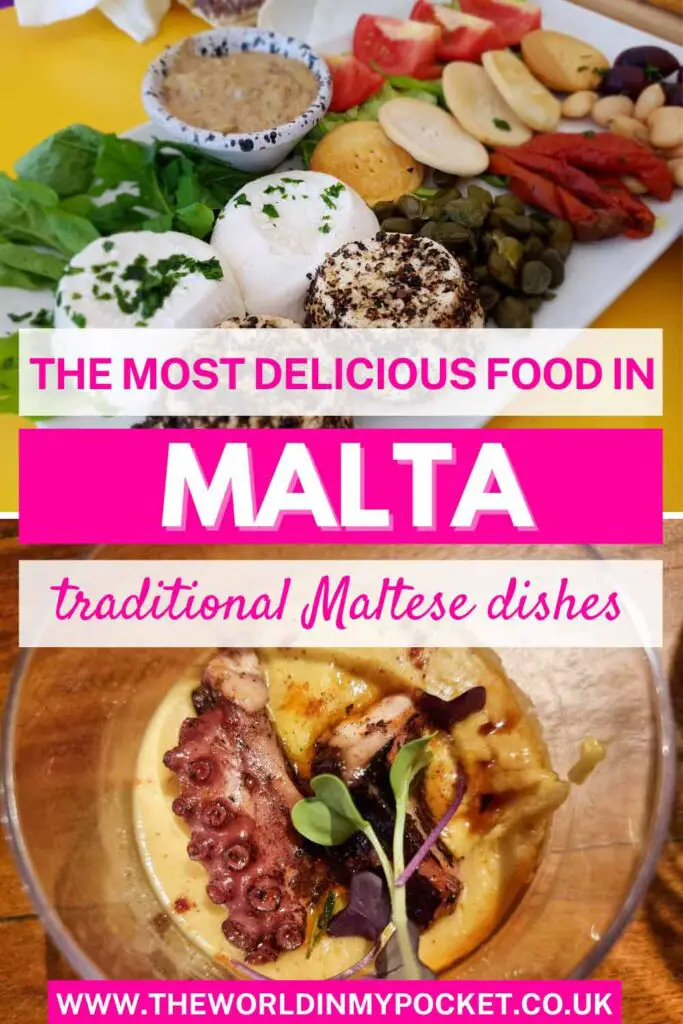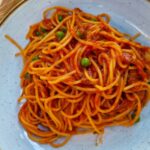Traditional Maltese food is a fantastic blend of influences from its neighbouring countries, but also from the British as well as the French. When I first went to Malta I didn’t know anything about the local cuisine. So when I returned to this beautiful sunny Mediterranean island, I decided to research more about the local delicacies and create a guide on what to eat in Malta.
Traditional Maltese food can be both light and hearty, a fantastic challenge for your taste buds. In this article, prepare to embark on a gastronomic journey, discovering the best dishes the Maltese cuisine has to offer. All tried and tested by yours truly.
Traditional Maltese Cuisine

Traditional Maltese cuisine is a testament of the island’s history and culture. Over the centuries, Phoenicians, Romans, Arabs, Normans, and other Mediterranean civilizations have left their indelible mark on the local culinary traditions. The result is a tapestry of flavours, blending influences from North Africa, Sicily, the Middle East, the British and the French, which together create an unforgettable culinary experience.
As I explored different parts of Malta and Gozo, I noticed how the typical dishes differ so much from one place to another. Take the ftira for example, which is one of the most popular dishes in Malta. It is very different on the main island than in Gozo. It’s the same with the cold platters and even the cheese. Whilst in the middle of the island I found more hearty dishes, the South is a paradise for fish lovers. The fertile soils yield an abundance of sun-kissed vegetables, such as juicy tomatoes, plump olives, fragrant herbs, and the iconic Maltese wild fennel which is heavily used to aromatise traditional dishes, such as the rabbit stew. The shores of Malta are home to an abundance of fish and shellfish, including succulent lampuki (the local fish), tender octopus, and sweet prawns.
What to Eat in Malta

From the delightful Fenkata, a traditional rabbit stew slow-cooked with garlic, wine, and aromatic herbs to the inexpensive flaky pastizzi filled with ricotta cheese or peas, from the oniony Aljotta fish soup to the robust flavours of Bragioli beef roll stuffed with bacon, garlic and parsley, there is something in Malta for everyone, even for those more fussy eaters.
Pastizzi

You could say that Pastizzi is Malta’s national snack. You will find them everywhere and they usually cost around 50p each. They are great for a snack on the go or a quick lunch. Pastizzi are traditional savoury pastry filled with either ricotta or mushy peas, and are usually warm when you buy them because they are baked all day long due to their popularity. The pastry used in making Pastizzi is similar to the Greek phyllo pastry. You can tell what the filling is by the way the pastry is folded. If the pastry has a diamond shape, it is filled with ricotta. If it has more of a shell shape, it has curried mushy peas inside.

One of the best places to have Pastizzi in Malta is the Crystal Palace, in Rabat. Don’t let its appearance put you off, they are told to be the best Pastizzi on the island. The place is very authentic, small and simple, with locals sitting at the 3 tables squeezed inside, drinking beer and playing cards. Just go to the front and ask for their famous Pastizzi.
You will most likely find pastizzi at the breakfast buffet at your hotel too.
Ftira – Ftira Maltija

There are two types of ftira in Malta, depending where you are: on the main island or in Gozo. I tasted my first Maltese ftira on my first ever day in Malta, at Fontanella Tea Garden, in beautiful Mdina. I didn’t really know what to expect and I was hungry after spending the morning in airports and on the plane, so I ordered it. Little did I know that it would be as big as it was, I couldn’t finish it.
You could say that ftira, which is probably the most recognized traditional Maltese food, is a tuna sandwich when you first see it as that’s how it appears. But it is so much more. Inside the crusty fresh baked bread (similar to a ciabatta) I found a medley of typical Mediterranean flavours. Firstly, the round shaped bread is coated with olive oil on the inside, and then rubbed with ripe tomatoes. The bread is then seasoned with salt and pepper and the toppings are added: tuna, capers, pickled onions, olives.
Each bite into the ftira was a deeper dive into the fresh flavours: the succulent tuna, the tangy capers, the briny olives. Delicious!
Gozitan Ftira – Għawdxija tal-ġbejna

The Gozitan ftira is very different from the Maltese ftira above. The only thing they have in common is the bread dough. The ftira from Gozo is closer to the Italian pizza by looks but has a unique taste. While the base is made out of bread dough, the filling is local cheese (fresh sheep or goat cheese and peppered mature cheese) with thin slices of potato on top. If you love cheese, as I do, you will love the Gozitan ftira as well.
The fresh Maltese cheese, Ġbejna, has a milky flavour and it’s similar to mozzarella or ricotta in texture, but with a much saltier taste. The peppered cheese is the same Ġbejna but cured and covered in crushed black pepper, making it crumbly and fairly spicy. Having both of them combined in a ftira is a proper treat.
The Maltese Platter

If you want a taste of the most delicious bites Malta has to offer, you have to try the Maltese or the Gozitan platter. The star of the platter is usually the delicious ġbejniet, Malta’s own cheese made from either cow or goat milk. The cheese usually comes in two different versions on a platter: fresh – which is creamy and mild, and dried – which is tangy and salty, sometimes with a crust of pepper, chilli, or herbs.
The Maltese platter will often have the most typical Maltese sausage on them as well, they are made with pork and coriander seeds, and are served grilled.
Next, the platters will usually come with at least one dip, the most popular being the broad beans based Bigilla and the olive and tomato based Arjoli. Bringing colour to the platter there will always be green olives, capers, sun dried tomatoes, and white beans. Usually the platters will come with two types of bread: the traditional galetti water biscuits, and the crusty Maltese sourdough.
Rabbit Stew – Stuffat Tal-Fenek

Rabbit is one of the most popular meats found in Malta, with many dishes using it as the main ingredient. Rabbit stew is considered to be the national dish of Malta, mentioned in every guidebook as a must try dish. It is a recipe that is passed from generation to generation, and each family has their own version, with secret ingredients and processes that are forbidden to be shared.
Rabbit stew is a celebratory dish, often served at family gatherings and celebrations. It is a cultural dish that for generations has been bringing family and friends together, to the dinner table. Rabbit stew, or stuffat tal fenek in Maltese, is a labour of love that usually starts the day before cooking, with the marinating of the meat, usually in red wine and different herbs and spices.
The end result is a very tender and succulent meat, extremely aromatic, in a delicious red sauce. It is usually served alongside roast potatoes seasoned with fennel seeds and crusty bread.
Fried Rabbit – Fenek Moqli

Another great way to enjoy rabbit in Malta is by ordering a Fenek Moqli. In this typical Maltese dish, the rabbit is fried and then sauteed in a delicious garlic and white wine sauce.
I was quite surprised to receive half a rabbit on the plate, when I ordered this dish, including organs and bones. As pretty much everywhere in Malta, the portion was huge and I struggled to finish it. The rabbit was flavoursome but a little tricky to eat because of the small bones.
I had the rabbit at Luciano’s Restaurant in Valletta, which has a large outdoor terrace just next to St John’s Co-Cathedral walls. The place was very nice but quite busy, which made the service a bit slow.
Rabbit Spaghetti

Another great traditional Maltese dish that you will find all over the island is the rabbit spaghetti. The sauce for this pasta dish is the same as the rabbit stew. Originally, the offal of the rabbit would be taken out, mixed with a ladle of sauce, and served with spaghetti as an appetiser, before the main event of the dinner: the stew. However, restaurants are using slow cooked meat and not offal to make this dish.
The rabbit spaghetti is usually cooked with fresh peas as well. The dish is extremely decadent and has a deep flavour. I highly recommend ordering the appetiser size, as it can be quite heavy, it is however a luscious dish.
Rabbit Liver – Fwied Moqli bit-Tewm
In Maltese cuisine, nothing is wasted from the animals, which means that there are various recipes using the offal. The Fwied Moqli bit-Tewm is exactly that. This typical Maltese dish is often served as an appetiser. It consists of rabbit liver cooked in a garlic and butter sauce, seasoned with thyme and softened with orange zest and juice.
Maltese Bread

Maltese bread is at the heart of the local cuisine. It is served on its own, accompanying main meals, alongside the treats of the Maltese platter, and with many delicious spreads.
Maltese bread is a type of sourdough with a rustic look, crunchy crust and the softest interior. It is usually baked in wood ovens, over an open fire which gives it its specific toastie flavour. The bread tastes great on its own, and it’s even better with toppings, which is a typical way to consume in Malta. The bread is grazed with a fresh tomato paste and drizzled with olive oil.
Maltese Cheese – Ġbejna

Malta produces its own cheese, which is so versatile that it comes in four different varieties using the same cooking process. Cheese is one of those delicious Maltese products that you must eat in Malta. It is very interesting to know that most of the milk that is collected in Malta is used to make these small cheeselets that are so loved by locals and tourists alike.
Most of the Ġbejna is made using cow milk, though there are varieties that use goat milk as well. I visited an ecological farm in the south of the main island, where they were producing Ġbejna using milk from two Jersey cows, which is much easier to digest for people like me, who suffer from lactose intolerance. Not that I would ever give up cheese, it’s one of those foods that is worth suffering for.
The first production of cheese is the fresh Ġbejna, which is soft and creamy, very similar to the Italian ricotta. This is used to make the pastizzi. The fresh cheese that is not sold goes through an ageing and drying process, which hardens it up and gives it a much saltier taste. Some varieties are then processed even more, being covered with pepper, chilli, or herbs.
During my last trip to Malta I met a local cheese producer who likes to experiment with these little cheeselets. Besides the classic varieties he created fennel honey Ġbejna using honey produced from fennel flowers, as well as red wine Ġbejna.
Bigilla

Bigilla is the classic Maltese dip which you will find everywhere on the island. It is one of those dishes that you must try in Malta. It consists of dried broad beans, mashed together with garlic, herbs, olive oil, and a pinch of chilli.
I thought Bigilla was very similar with the ful medames in Egypt, a breakfast staple around the Middle East. The addition of chilli makes it specific to Malta.
The Bigilla is usually served with Galletti, which are Maltese water crackers.
Kapunata
Kapunata is a delicious spread very similar to the Sicilian caponata, which is where the inspiration came from. It is a delicious cold salad that is often present on the Maltese platter, or served on its own alongside Maltese bread, as an appetiser.
The salad is made from summer vegetables such as tomatoes, aubergines, onions and peppers, cooked alongside olives, capers, garlic, and tomato paste, seasoned with mint. What makes the Maltese kapunata special, and different from its Sicilian sister, is the way it is cooked, as well as the add-on of peppers and mint. Whilst in Sicily the caponata is cooked all together in a pan, the vegetables that make the kapunata are prepared separately. Only at the end, once all the vegetables have been softened in the pan separately, are then brought together and seasoned with mint.
Kapunata is a delicious refreshing summer Maltese appetiser, perfect to order when the temperatures are too hot to order hot food.
Cauliflower Fritters – Frituri tal-Pastard

I was intrigued by the Maltese cauliflower fritters when I’ve seen them on a menu, so I ordered them. I received a plate with small patties made from a mixture of cauliflower, potatoes, capers and thyme, which had a very delicate, mild taste. They were served with a sheep’s cheese sauce which gave the dish that boost of balancing flavours, which completed it.
They were very light, with an extremely soft texture that melts in your mouth.
Lampuki

Lampuki is the most popular fish in Malta, which you will find fresh in the fishing village of Marsaxlokk. The traditional Maltese way to cook lampuki is to dip it in flour and deep fry in oil. A sauce is made separately from onions, tomatoes, olives, and capers. The fish is served with the sauce on top.
You can order steamed lampuki as well, which is what I went for, to avoid the deep frying. The lovely fillet was served with the tomato and onions sauce on top, alongside a fresh salad and a bowl of roast potatoes. I enjoyed it at a restaurant in Valletta, alongside a cold pint of local Cisk beer.
Fish Pie – Torta tal-Lampuki
Torta tal-Lampuki is a traditional Maltese dish that uses the famous lampuki fish, so typical to the islands. It is a hearty pie generously filled with a mixture of fish, onions, tomatoes, peas, spinach, black olives, capers and mint. The crust is very similar with puff pastry, flaking at each bite.
Maltese Octopus Stew

Octopus stew is another delicious, very light, Maltese speciality. The octopus is cooked in a delicious, Mediterranean flavoured sauce, with onions, garlic, sun ripened tomatoes, capers, olives, peas, and red wine. Sometimes, there are potatoes added to the stew as well.
To infuse with all the aromas of the other ingredients and to create that delicious sauce in which you won’t help dipping the crusty bread over and over, the octopus is simmered on a low heat for a long time, usually up to two hours.
Aljotta

Aljotta is one of the most popular soups in Malta. The broth of this soup is usually made from different types of fish, whatever the fishermen caught that day and can’t be used in larger dishes. The whole fish is cooked in its entirety, alongside prawns sometimes, because the head, tail and bones enrich the broth, giving it a more deep and intense flavour.
Aljotta is a very light soup, with a surprising potent garlic flavour. When it comes on the plate, it consists of a clear broth with deboned pieces of fish and chopped onion inside.
Greek Pasta – Ghagin Grieg

Ghagin Grieg is a very interesting Maltese dish that I only found in one highly rated restaurant, as a special house recipe. After doing a little bit of research, I found out that its name translates as Greek pasta, because the sauce is inspired from this part of the world. However, the recipe is pure Maltese. Each family has their own typical recipe, and this is why I’ve seen it on the menu as a family special.
The pasta used to make Ghagin Grieg is very small, like tiny beads. It is cooked al dente, and mixed with a delicious sauce made using minced pork meat, onions and garlic, white wine, and generous amounts of parsley and Maltese cheese.
Timpana

This delicious Maltese dish reminded me a little bit of the Greek Pastitsio, which in turn was inspired from Italy. Timpana consists of layers of macaroni or penne pasta, minced meat, bacon, tomato sauce, different vegetables, boiled eggs, and parmesan cheese, among others. All this concoction is enclosed inside puff pastry which when baked becomes golden and gets a crispy texture.
This is a perfect hearty, comfort dish to order during the winter months, when the temperatures in Malta drop.
Bragioli

If you thought that the Maltese food was all about rabbit and fish, let me introduce you to the islands’ most popular beef dish: the Bragioli. This beef roll has a fun name, which translates to beef olives. However, there are no olives in this recipe. The name reflects the shape of the beef.
Bragioli are beef rolls stuffed with a mixture of bacon, boiled eggs, parsley and breadcrumbs, before being slowly cooked in a red wine based sauce. The beef used to make Bragioli is sirloin, which after cooking becomes so tender that it melts in your mouth.
Imqaret

Whilst normally I am not very keen on dates, I loved the Maltese imqaret, this diamond shaped pastry filled with a rich date cream. The imqaret is a very popular sweet in Malta and you can find it everywhere for a very inexpensive price.
Each imqaret is made individually by hand and is filled with a generous quantity of date paste, before being deep fried and infused with bay leaves and aniseed. The best way to have imqaret is hot, ideally served with ice cream, which balances the flavours, as the pastry is quite sweet. I had it alongside halwa flavoured ice cream, which was so good! Halwa is a dessert made from crushed almonds and honey.
Honey Rings

Honey Rings are a Maltese sweet that originally was made only during Christmas time. These days however, you can find it everywhere, including the duty free at the airport, if you fall in love with it and want to bring some honey with you.
You can find honey rings in bakeries, but also sold by ambulant vendors, around the Dingli Cliffs. They consist of a hard-ish pastry filled with a moorish mixture of honey, cinnamon, cloves, aniseed and cocoa.
Kinnie

When it comes to typical drinks that you must have in Malta, Kinnie comes to mind first. Kinnie is a very unique drink, quite bitter but also refreshing. It is made from bitter orange and an aromatic plant called woodworm. The recipe for Kinnie is kept secret, so nobody knows what exactly makes this drink so good.
Kinnie is so deep rooted into the culture of Malta that is considered the national drink of the country.
Cisk

Cisk is the national beer of Malta. Recently they have opened their brewery to the public, with tours as well as a state of the art rooftop bar, Cisk Tap, which has lovely views over the main island, especially during the evening.
Cisk Beer, is a fermented lager with a distinct flavour profile, that has solidified its position as Malta’s favourite brew since its establishment in 1929. It has a golden colour and a refreshing hoppy flavour profile. Over the years Cisk has introduced new beers, currently having a collection of nine different varieties, including fruit flavoured summer ones.
Conclusion

I hope you enjoyed my article about what to eat in Malta. I surely had a great time trying out as many Maltese foods as I could – the best way to research the Maltese cuisine. The dishes I selected in this article were my favourite Maltese dishes that I have personally tasted in Malta. If you are interested in more about this beautiful country, you can check out my article recommendations below, or ask me a question in the comment section.
Q&A:
What food is popular in Malta?
Malta has many popular dishes but the traditional ones are based on rabbit. The Maltese cuisine is rich and hearty, with a lot of Italian and Arabic influences.
What is the most famous food in Malta?
The most popular food in Malta is the rabbit stew. Also, the pastizzi are high out there, especially as a snack that can be eaten at any time of the day. The best pastizzi in Malta is at Crystal Palace, in Mdina.
What is the national food in Malta?
The answer to this question is again, the Stuffat tal-Fenek – rabbit stew. This rich, delicious stew can be eaten at any of the traditional Matese restaurants on the island.
Which traditional Maltese food would you like to try and why?
For more articles about Malta, check out my recommendations below:
Like it? Pin it!

Disclaimer: Some of the links on this website are “affiliate links.” This means that if you click on the link and do a purchase, I will receive an affiliate commission at no extra cost for you. This helps me keep my website running and continue to share my travelling knowledge with you. I thank you for booking your flights or hotels using the links on my website. Regardless, I only recommend products or services I use personally and believe will add value to my readers.





Mmmmmmmm! The food from Malta looks very delicious and mouthwatering. If I ever visit in future I must remember to try them.
Pingback: What to Do in Malta in 3 Days to Make the Most of a Short Trip
Pingback: Exploring the Old Maltese Capital Mdina and the Village of Zurrieq
My two very favourite Maltese foods are Torta tal-Ghara Hamra (Pumpkin pie) and Qassatat (like pastizzi but with pie pastry). I could live on them every day of my life and not get bored. I’d get really fat. But I’d never get bored! 😉
These all look delicious. My favourite or at least the one that draws me the most is the platter that looks wonderful.
I would like to try all of the foods! I think the cheese ftira interests me the most because I am a cheese lover. But I also love the rabbit. I have a big appetite, so I think I could handle the giant portions. I also like dates so the date pastries sound good too.
I love pastizzis! I had no clue they were from Malta though. Not sure I would be keen to try the rabbit but when in Rome right …
That’s interesting that rabbit is the national dish. Do you think that is the case anywhere else. Your post reminded me that I haven’t had any dates yet this year!